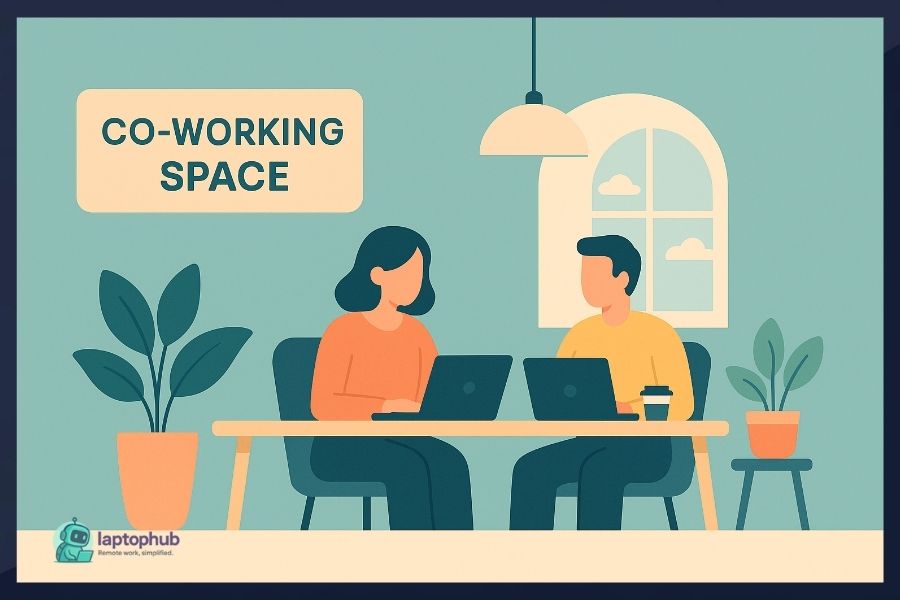The home office can get claustrophobic, cafés are noisy, and working solo every day slowly wears you down. A co-working space bridges the gap—offering flexibility, focus, and community without the overhead of a traditional office. It’s not just a desk or Wi-Fi; it’s a place where people actually want to get work done. Whether you’re a freelancer chasing deadlines or a startup team trying to grow, the right space can change how—and how well—you work.
💡Key takeaways:
- A co-working space is a flexible, shared work environment designed to support independent workers, remote teams, and small businesses.
- These spaces offer a mix of hot desks, private offices, and amenities like fast Wi-Fi, meeting rooms, and community events.
- Co-working is popular because it provides structure, productivity, and social connection without the rigid feel of a traditional office.
- Choosing the right space depends on your work style, needs, budget, and the environment that helps you stay focused and energized.
What Exactly Is a Co-Working Space?
A co-working space is a shared, flexible work environment where individuals from different companies or backgrounds can work side by side—without the rigidity of a traditional office or the distractions of home.
You don’t have to be part of a team or company to use one. Whether you’re a freelancer, entrepreneur, startup founder, or remote employee, you simply rent a workspace—sometimes by the hour, often by the month.
The vibe is usually modern, open, and professional, but without the corporate stiffness. Picture long communal tables, quiet nooks, private call booths, solid Wi-Fi, and yes—good coffee.

Why Co-Working Spaces Exist (And Why They’re Booming)
The traditional 9-to-5 office was built for a different era. These days, more people want flexibility, autonomy, and mobility in their work. That shift gave rise to freelancers, solopreneurs, digital nomads, and remote teams.
But here’s the catch: working from your bedroom or kitchen table every day can slowly chip away at your focus, creativity, and even your mental health.
Co-working spaces emerged to fill that gap.
They’re designed for:
- Professionals who need a workspace without committing to a long-term lease
- Remote workers who miss the structure and social element of office life
- Freelancers tired of the same four walls
- Startups that need meeting rooms, not office politics
- Creators, consultants, and small teams looking for flexibility and focus
It’s not just a trend—it’s a reflection of how modern work is changing.
What You’ll Typically Find Inside a Co-Working Space
Not all co-working spaces are created equal. Some cater to tech startups. Others to creatives. Some are sleek and corporate; others are cozy and community-driven.
That said, here’s what most well-run spaces offer:
1. Hot Desks
These are open, unassigned desks or tables. First come, first served. It’s usually the most affordable option.
2. Dedicated Desks
A reserved desk that’s yours every day. You can leave your monitor, gear, and personal items. Great for those who like consistency.
3. Private Offices
Ideal for teams or individuals who need privacy. They cost more but come with lockable doors, whiteboards, and peace.
4. Meeting Rooms
Most spaces offer reservable rooms equipped with screens, whiteboards, and video conferencing setups.
5. Amenities
Depending on the space, this might include:
- High-speed fiber internet
- Kitchen access
- Free coffee and snacks
- Printers and scanners
- Phone booths
- Event spaces
- Lockers
- Showers (yes, really)
- Podcast or video recording studios
6. Community Perks
This is what sets many co-working spaces apart from just being a desk-for-rent:
- Networking events
- Skill-sharing workshops
- Lunch-and-learns
- Member directories or Slack groups
- After-hours socials or mixers
You’re not just paying for a desk—you’re joining a community of like-minded professionals.
Who Actually Uses Co-Working Spaces?
You’d be surprised at the variety. During one random Tuesday morning at a co-working space I used to frequent, here’s who I was surrounded by:
- A UX designer building an app
- A CPA doing tax prep for clients
- A YouTuber editing videos
- A corporate recruiter interviewing candidates over Zoom
- A lawyer reviewing contracts
- A non-profit consultant writing grant proposals
- A guy launching a travel gear e-commerce site
The takeaway? Co-working spaces attract people who want flexibility without sacrificing productivity. Some come daily. Others pop in once a week or only for client meetings.
Benefits of Using a Co-Working Space
Let’s talk about what you really want to know: Why should you bother paying for a space when home is free?
1. Separation of Work and Life
One of the biggest challenges of remote work is knowing when to stop. When your office is your kitchen, it’s hard to draw the line. Co-working spaces give you that mental and physical boundary.
2. Boost in Productivity
When you’re surrounded by focused people, you work differently. Co-working spaces offer fewer distractions than home (no laundry, no Netflix) and a more intentional work environment than a coffee shop.
3. Professional Image
Need to meet clients or pitch investors? A co-working meeting room beats a noisy café any day. It shows you’re serious and prepared.
4. Networking Without the Awkwardness
You don’t need to hand out business cards. Just show up consistently. You’ll naturally start conversations, find collaborators, and maybe even land clients.
5. Community Support
Freelancing and remote work can get lonely. Being part of a co-working community means you’ve got people to chat with, bounce ideas off, or ask for advice.
6. Flexible Plans
Most spaces offer everything from day passes to monthly memberships. You can scale up or down based on your needs.
7. Access to Resources You Don’t Want to Buy
Like a high-speed printer, podcast gear, ergonomic chairs, or a standing desk.
Common Drawbacks to Consider
Nothing’s perfect. Here’s what might bug you about co-working:
1. Cost Adds Up
Even a basic membership can cost $150–$400/month depending on your city. Private offices can hit $800+. That’s a real expense if you’re just starting out.
2. Noise Levels Vary
Some spaces are quiet and focused. Others have a coffee-shop vibe, with conversations happening in the background. Not great if you’re easily distracted.
3. Lack of Privacy
Hot desking means you don’t control your neighbors. One day you sit next to a silent coder. The next, a sales guy on back-to-back calls.
4. Commute Returns
One of the perks of working remotely is avoiding traffic. If your co-working space isn’t nearby, that benefit’s gone.
5. Not All Spaces Are Created Equal
Some look great in photos but feel disorganized or poorly maintained in person. Always take a tour before committing.
How to Choose the Right Co-Working Space
This isn’t a one-size-fits-all deal. Here’s what to look for when choosing:
- Location: Is it easy to get to? Safe? Near home or clients?
- Atmosphere: Do you prefer quiet focus or creative energy?
- Membership Options: Is there a flexible plan that fits your schedule and budget?
- Amenities: Do they have what you need, not just shiny extras?
- Internet Speed: Crucial. Don’t assume—it should be fast and reliable.
- Community Vibe: Are people friendly? Are there events or networking opportunities?
- Trial Day: Most spaces offer one. Take advantage before signing up.
Tip: Use sites like Coworker.com or Deskpass to browse and compare spaces in your city.
Co-Working vs. Home Office vs. Traditional Office
Here’s how they stack up:
| Feature | Co-Working | Home Office | Corporate Office |
|---|---|---|---|
| Flexibility | High | Highest | Low |
| Cost | Medium | Low | Paid by employer |
| Productivity | High | Variable | High (with meetings) |
| Networking | Optional | Low | Built-in |
| Privacy | Moderate to High | High | Variable |
| Social Interaction | Moderate | Low | High |
| Commute | Short (usually) | None | Long (often) |
| Work-Life Balance | Improved | Blurred | Clear |
🖥️Also read: How to Build the Perfect Home Office Setup—Even in Small Spaces
My Real-World Take as a Longtime Freelancer
Early in my freelance career, I thought I’d cracked the code by working from home. I had no boss, no dress code, and total freedom.
But slowly, I started slipping. My routines got loose. I lost motivation. I started working odd hours and feeling disconnected. And let’s not even talk about the cabin fever.
Trying out a co-working space changed that. Suddenly I had structure. I’d leave the house with purpose, get a full day of focused work done, and come home feeling like I earned my evening. The work-life boundary got real again.
I met clients there. Got referrals. Even made friends. Now, I alternate: three days at the co-working space, two at home. That balance works for me—and that’s the beauty of it. You shape it around your life, not the other way around.
Co-working space FAQs
A co-working space is used as a flexible workspace by freelancers, remote employees, startups, and small businesses who want a productive environment without signing a long-term lease.
It depends on your work style, but many people find co-working improves focus, separates work from home life, and reduces isolation.
Some are, but most offer quiet zones or phone booths for calls—just make sure to tour before you join.
Prices vary by city and amenities, but typical rates range from $150 to $500/month for a hot desk, and more for a private office.
Yes—many have professional meeting rooms you can book, which is much better than trying to talk business over loud café music.
Final Thoughts: Is a Co-Working Space Worth It?
If you’re grinding away solo and wondering if your workday could feel less like a slog and more like a groove, a co-working space might be the move you didn’t know you needed.
It’s not just about a desk. It’s about space to focus, a community to connect with, and a clearer line between “on the clock” and “done for the day.”
Try one out for a day. You’ll know quickly if it’s your vibe or not.





